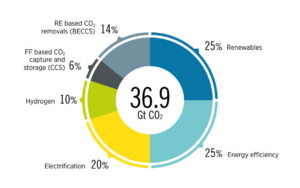What is the clean economy?
Understanding the tools that enable net zero emissions is essential to developing the clean economy workforce.

The clean economy is an equitable, prosperous and net zero emissions economy. It is an economy in which the United Nations Sustainable Development Goals (SDGs) have been achieved. It is an economy in which biodiversity is thriving, and human civilisation is flourishing. Sounds good right? It is.
But to build a clean economy, we must grow the clean economy workforce.
In the future, the clean economy workforce will be the entire workforce. But as we transition to a clean economy, the clean economy workforce is the workers that are committed to decarbonising our buildings, industry and transport. This workforce is varied, with both traditional technical roles like Electricians and Engineers, and non-technical roles like Community Engagement Advisors and Net Zero Business Advisors, being essential to achieving a clean economy.
It is critical we have enough skilled workers to build the clean economy and reach net zero emissions by 2050. And these skilled workers must be able to deliver four core decarbonisation activities:
- Carbon removals;
- Circular economy solutions;
- Energy efficiency and electrification; and
- Renewable energy.
Energy efficiency, electrification and renewables are the most important tools as energy is currently responsible for approximately 80 per cent of Australia’s emissions. But circular economy solutions and carbon removals are essential to decarbonising the final 20 per cent of emissions.

Source: International Renewable Energy Agency (IRENA) 2022, World Energy Transition Outlook 2022.
Energy efficiency and electrification are expected to provide 45 per cent of the total decarbonisation effort globally. But what is energy efficiency?
Energy efficiency means getting more out of every unit of energy used. Modern, efficient appliances can achieve the same outcomes but use far less energy – sometimes as much as 80 per cent, as is the case for modern LED lighting. Electrification of buildings, transport and industry involves replacing technologies that use fossil fuels, with ones that run on electricity – ideally renewable electricity.
Energy efficiency and electrification also support demand flexibility, which gives consumers and businesses the ability to change when they use energy to support a renewable electricity system powered by solar and wind. Together, energy efficiency, electrification and demand flexibility, are often referred to as ‘energy management’.
Learn more about energy efficiency and electrification in Putting energy efficiency to work.
Renewable energy is produced using natural resources that are constantly replaced and never run out, including solar, wind and hydropower. There are both renewable electricity and fuels, with solar, wind and water being used to directly generate electricity, and indirectly generate green hydrogen fuel. Alongside green hydrogen, biofuels such as liquid fuels produced from algae or gaseous fuels from pig poo, are also renewable fuels.
Learn more about renewable energy from the Australian Renewable Energy Agency (ARENA).
Circular economy solutions reuse products, rather than scrapping them and extracting new resources. They support the decarbonisation of industrial processes, such as by manufacturing green steel and green cement, or decarbonising agriculture by feeding cows seaweed to support lower methane emissions.
In such an economy, all forms of waste, including clothes, scrap metal and electronics, are returned to the value chain. This provides a way to not only protect the environment, but also use natural resources more wisely, develop new sectors, create jobs and develop new capabilities – all of which are key components of the clean economy.
Learn more from the United Nations Conference on Trade and Development (UNCTAD).
Carbon removals are critical to supporting our decarbonisation efforts. Carbon removals must be credible, but those that are, are essential to supporting short term decarbonisation efforts, compensating for parts of the economy for which we don’t develop a technical decarbonisation solution prior to 2050, and for enabling negative emissions post 2050. Realising these three emissions reductions goals is essential to staving off the worst impacts of climate change, enabling us to live healthily and happily for generations to come.
Carbon removals involve both natural and artificial solutions that remove carbon dioxide from the atmosphere and store it in trees, oceans, soils and underground reservoirs. Carbon removal and storage requires unique skillsets that are becoming increasingly important as the deadline to reach net zero approaches.
Learn more from the World Resources Institute (WRI).
We need enough skilled people to deliver these four key solutions to building a clean economy. Browse our careers pages to learn which careers utilise which of these decarbonisation tools.